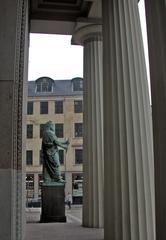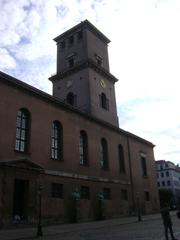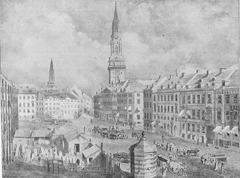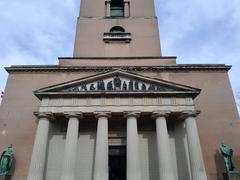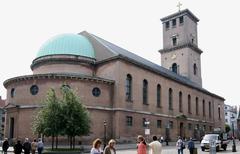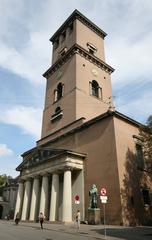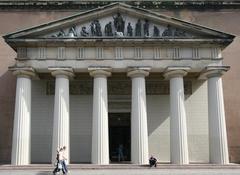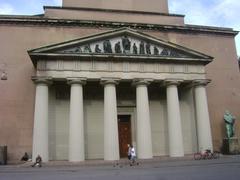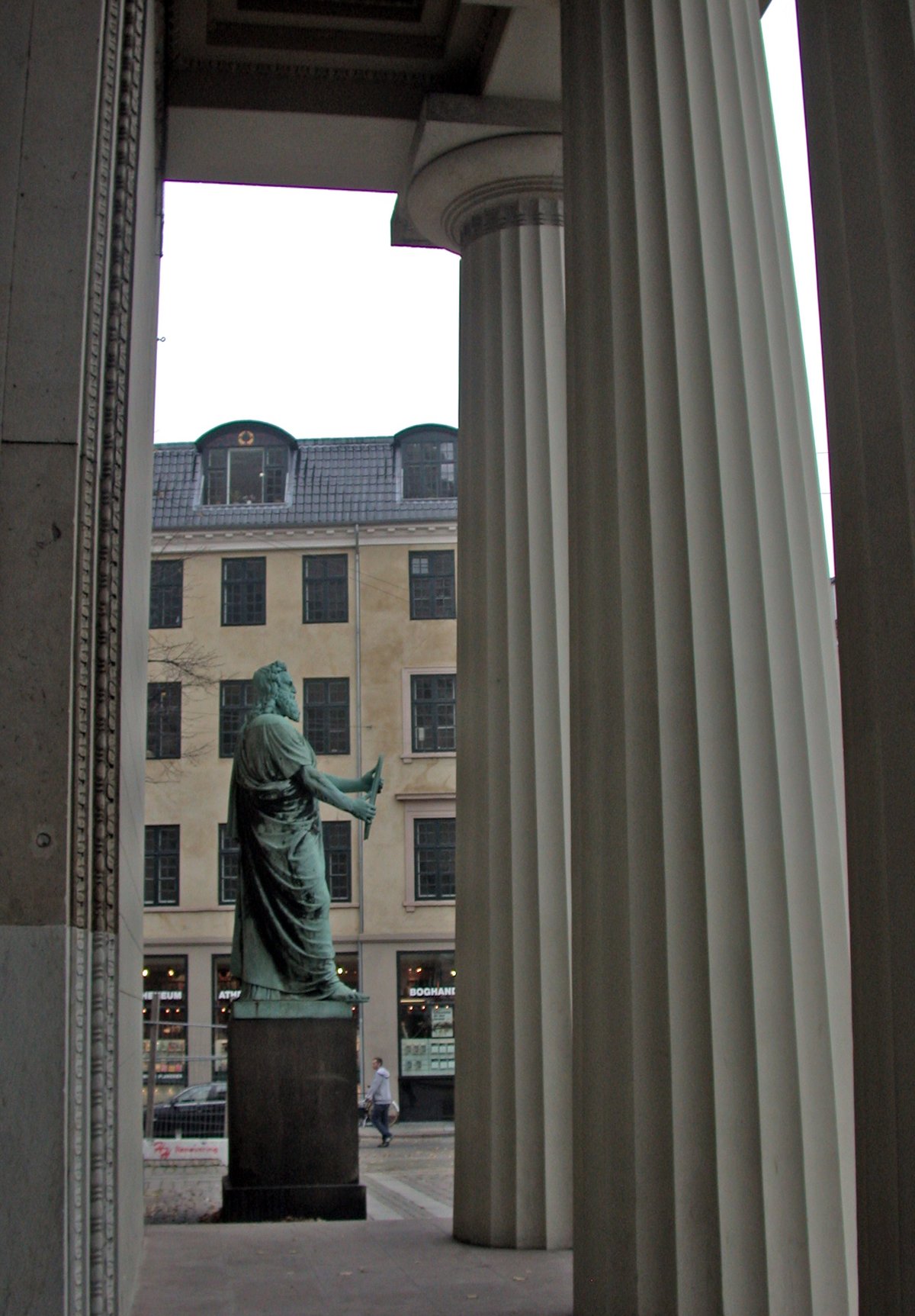
Church of Our Lady Copenhagen: Visiting Hours, Tickets, and Complete Guide
Date: 14/06/2025
Introduction
Located in the heart of Copenhagen, the Church of Our Lady (Vor Frue Kirke) stands as Denmark’s national cathedral and an enduring symbol of the city’s historical, religious, and artistic legacy. Renowned for its striking neoclassical architecture and the masterpieces of Bertel Thorvaldsen, the church attracts a diverse array of visitors—architecture enthusiasts, history buffs, art lovers, and spiritual seekers alike. This comprehensive guide covers essential information on visiting hours, ticketing, tours, accessibility, and insider travel tips, ensuring you make the most of your experience at one of Copenhagen’s most treasured landmarks.
For official details and further exploration, visit the Church of Our Lady official website. Related cultural attractions include Rosenborg Castle and The Round Tower.
Historical Overview
Medieval Foundations and Rebuilding
The Church of Our Lady’s origins trace back to the late 12th century when Bishop Absalon—Copenhagen’s founder—constructed the first church on this site. Documented as early as 1185, the church has undergone numerous cycles of destruction and reconstruction due to fire, war, and urban development. Notably, the original medieval structure was rebuilt multiple times, with remnants of earlier versions still preserved beneath the present cathedral.
Neoclassical Transformation
After being severely damaged during the British bombardment of Copenhagen in 1807, the church was completely rebuilt between 1817 and 1829 under the direction of Christian Frederik Hansen. This iteration exemplifies neoclassical ideals—clarity, symmetry, and grandeur—with an imposing portico, Ionic columns, and a soaring 60-meter tower. The design harmonizes with ancient Greek and Roman architectural traditions, distinguishing it from other churches in the city.
Artistic Legacy: Thorvaldsen’s Sculptures
The interior features remarkable neoclassical sculptures by Bertel Thorvaldsen, including the iconic Christus statue at the altar and the twelve apostles lining the nave. Carved from Carrara marble, these works are celebrated for their spiritual symbolism and classical beauty. Thorvaldsen’s baptismal font and intricate reliefs further enhance the sacred atmosphere.
Religious and Cultural Significance
Originally established as a Roman Catholic church, the cathedral became Lutheran after the Reformation. It has played host to royal ceremonies, state funerals, and significant national events, serving as a central hub for both religious life and cultural celebrations in Denmark.
Neoclassical Design and Interior Highlights
Exterior and Urban Integration
The church’s façade features a stately portico with six Ionic columns and a triangular pediment, constructed from pale sandstone. Its understated elegance contrasts with the more ornate Baroque and Gothic churches nearby. The bell tower rises 60 meters above the city, serving as a recognizable landmark within Copenhagen’s skyline (evendo.com).
Interior Layout
Inside, visitors experience a vast, light-filled basilica plan. Tall arched windows and a coffered ceiling create an atmosphere of serenity and openness. The apse at the eastern end, framed by a semicircular colonnade, serves as the focal point with Thorvaldsen’s Christus statue presiding above the altar.
Artistic and Structural Features
- Sculptures: Thorvaldsen’s twelve apostles and Christus are the artistic heart of the church (mypathtotravel.com).
- Decorative Elements: The church favors geometric patterns and restrained ornamentation, in keeping with neoclassical aesthetics.
- Structural Innovations: Hansen incorporated iron reinforcements to create an airy, columned interior without heavy buttresses (evendo.com).
Cultural and Religious Role
National and Spiritual Importance
As the seat of the Bishop of Copenhagen, the Church of Our Lady is the mother church for the Diocese and hosts major religious ceremonies such as royal weddings and state funerals. It is also a venue for concerts, lectures, and cultural events, welcoming approximately half a million visitors annually (vorfruekirke.dk).
The Christus Statue’s Global Influence
Commissioned in 1820 and installed in 1833, Thorvaldsen’s Christus has become an internationally recognized symbol of hope and redemption. Its open-armed pose invites all, transcending denominational boundaries, and has been adopted as an emblem by The Church of Jesus Christ of Latter-day Saints. The original plaster models are on display at the nearby Thorvaldsen Museum (thorvaldsensmuseum.dk).
Interfaith and Community Engagement
Rooted in Lutheran tradition, the church embraces visitors of all faiths, fostering dialogue and reflection. Community outreach, concerts, and exhibitions contribute to its ongoing relevance as a cultural hub in modern Copenhagen.
Practical Visitor Information
Location and Accessibility
- Address: Nørregade 8, 1165 Copenhagen, Denmark
- Public Transport: Easily reached by metro (Nørreport Station), bus, and by foot or bicycle.
- Accessibility: The main entrance is wheelchair accessible; ramps and spacious interiors accommodate visitors with mobility challenges. The bell tower is accessible only by stairs.
Visiting Hours
- General Hours: 10:00 AM – 4:00 PM (Monday–Saturday); 12:00 PM – 4:00 PM (Sunday)
- Holiday Closures: Check the official website for updates during public holidays and special events.
Tickets and Admission
- Entry: Free of charge for individual visitors.
- Special Experiences: Some features, such as bell tower access and guided tours, may require advance booking or a modest fee.
Dress Code and Etiquette
- Dress respectfully, covering shoulders and knees, especially during services.
- Photography is allowed for personal use; avoid flash and be discreet during religious ceremonies.
Special Features and Experiences
- Bell Tower Access: Climb 260 steps for panoramic views of Copenhagen. Access is limited to specific times and requires a ticket—book early to secure a spot.
- Organ Concerts: The church is renowned for its organ concerts. Check the schedule on the official website.
- Underground Ruins: At select times, visitors can explore archaeological remnants of earlier churches beneath the current cathedral, offering a tangible link to Copenhagen’s medieval history.
Nearby Attractions and Suggested Itineraries
- Strøget: The famous pedestrian shopping street is just steps away.
- University of Copenhagen: Adjacent historic university buildings.
- The Round Tower: A short walk to this iconic 17th-century observatory.
- Rosenborg Castle and Kongens Nytorv: Major landmarks within walking distance.
Visitor Services and Amenities
- Information Desk: Multilingual assistance and brochures available during visiting hours.
- Gift Shop: Sells religious items, local crafts, and souvenirs.
- Restrooms: Including accessible facilities.
- Seating: Benches and pews throughout the nave for rest and reflection.
Safety and Security
The Church of Our Lady is located in a safe, well-patrolled area. As with any popular site, visitors are encouraged to watch their belongings and behave respectfully.
Photography and Filming
- Personal Use: Allowed without flash.
- Professional Equipment: Requires prior permission.
- Commercial Filming: Must be pre-arranged with church authorities.
Events and Religious Services
Regular worship services, major ceremonies, and special cultural events are held throughout the year. Visitors are welcome to attend, but note that some areas may be closed during services or large events.
Frequently Asked Questions (FAQ)
Q: Do I need a ticket to visit the Church of Our Lady?
A: General entry is free. Special experiences (such as bell tower access) may require advance tickets.
Q: What are the visiting hours?
A: Typically, 10:00 AM–4:00 PM Monday–Saturday, and 12:00 PM–4:00 PM on Sundays. Check for holiday variations.
Q: Is the church accessible for wheelchairs?
A: Yes, the main entrance and nave are accessible. The bell tower is not.
Q: Are guided tours available?
A: Guided tours can be booked in advance and are highly recommended for those interested in history and architecture.
Q: Can I take photos inside?
A: Yes, for personal use. Please avoid flash and be discreet during services.
Tips for a Memorable Visit
- Arrive early or late for a peaceful experience.
- Consult the official website for updated hours and special events.
- Book bell tower tickets in advance.
- Combine your visit with nearby attractions for a full day’s exploration.
- Dress modestly and respect the religious nature of the site.
Conclusion
The Church of Our Lady is not only a masterpiece of neoclassical architecture and Danish artistry but also a living center of faith and community in Copenhagen. From Thorvaldsen’s iconic sculptures to the serene grandeur of the nave, every aspect invites contemplation and admiration. With free entry, accessible facilities, and a central location, it stands as an essential destination for anyone seeking to understand Copenhagen’s rich heritage. For further information, guided tours, and event updates, visit the official Church of Our Lady website.
Download the Audiala app for immersive audio guides, and follow us on social media for the latest news, concerts, and cultural events at Denmark’s national cathedral.
Sources
- Visiting the Church of Our Lady in Copenhagen: Hours, Tickets, History & Tips, 2025 (Church of Our Lady official website)
- Visiting the Church of Our Lady in Copenhagen: Architecture, History, and Visitor Information, 2025 (Evendo)
- Cultural and Religious Significance, 2025 (Vor Frue Kirke)
- Church of Our Lady Copenhagen: Visiting Hours, Tickets & Historical Guide, 2025 (Church of Our Lady)
